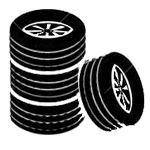My engine makes a 'tick tick tick' sound. What is it? Is there a fix?
This is commonly attributed to the hydraulic lash adjusters (lifters) used in the DSM cars. Other cars have similar problems - Mazda owners, for example, refer to them as HLA problems. Other possible causes include excessive carbon buildup on the valves and piston heads.
The general consensus is that this problem is not damaging to the engine. Indeed, many owners have lived with the problem for years with no side effects. In extreme cases, it is possible that the ticking may be picked up by the ECU as knock, causing a retardation in timing that will cost some engine power. This case seems to be the exception, not the rule, since the DSM ECU only 'listens' for knock during specific time intervals.
In the past, owners have reported that their tick appeared or went away with certain oil brands, oil weights, oil filters, oil pressures or the like. These 'solutions' appear to be car-specific and do not represent a real fix, but some experimentation may help alleviate the problem. Some owners find that adding a small amount of extra oil helps to raise oil pressures and minimize the ticking, but again, it doesn't work for everyone.
Yet another solution involves realigning the lifters in the engine to promote better oil retention. Jeff Brinkerhoff recently did so with excellent results, reported in the December 2, 1998 Digest. Bryan Cobb has followed his example with similar success. Check the FAQ Locator to find the procedure.
Simply replacing the problem lifters is unquestionably the best option. The lifters have been redesigned to eliminate the tick. There is a VFAQ on this process, which is not terribly difficult, and involves about as much work as realigning the existing lifters. Use the FAQ Locator to find it. The newer lifters apparantly do not rotate, and do not suffer from alignment problems.
There have actually been a few versions of the lifters. The original were Mitsubishi part number MD149309 used in 1990 to 1997 cars. A redesigned version (part MD337687) was then introduced, and was replaced yet again by part MD377054. This latest part number is reportedly the best version but the availability may be limited if dealerships still have some of the older part still in inventory.
Mike Ferrara focused on the problem of carbon deposits on the valves. It is a relatively dangerous procedure, as it involves pouring automatic transmission fluid into the intake of the engine. As fluids are incompressible, a miscalculation can literally devastate your engine. A few DSMers have experienced major engine damage from performing this procedure incorrectly. Thus, this procedure is not recommended for the novice mechanic
Rather than doing this dangerous procedure, those who have non-lifter tick problems should consider using Mopar Combustion Chamber Cleaner on their car. Other Digest members have had considerable success using it to clean major carbon deposits in the DSM engines. Read the Mopar Combustion Chamber Cleaner discussion captured on VFAQ page
Other sources of non-lifter tick include exhaust system problems including a cracked exhaust manifold, broken exhaust maifold bolt or stud, cracked turbine housing or other exhaust leak. Some owners have reported that their tick went away after changing, repairing or upgrading their manifolds. Others have found that their spark wires (whether new, old, upgraded or whatever) were arcing to the block, causing a sparking sound they mistook for lifter tick. This is usually detected by looking under the hood at a running engine in the dark. Finally, a few owners are sure their ticking is really the injectors firing.
QA #192
Last Updated:
2016-06-06 11:52







